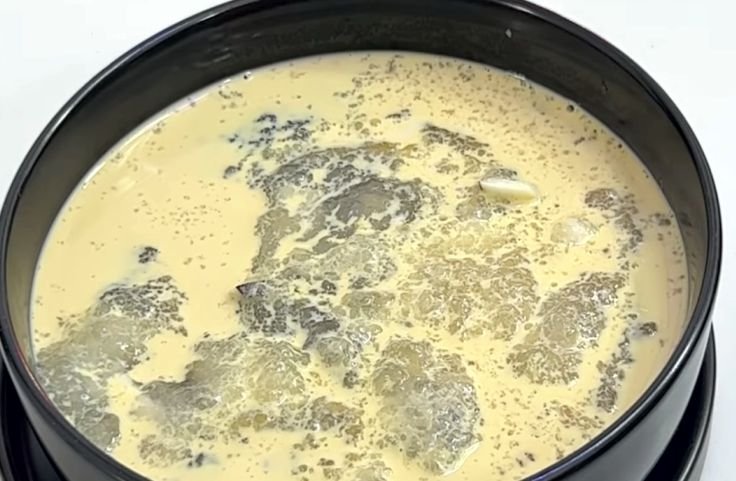Is tapioca pearls pudding good for you? That depends on your habits, portion sizes, and goals. Here’s what matters when this comfort food ends up in your bowl.
When you think of tapioca pudding, you may picture a bowl of creamy sweetness that reminds you of childhood.
But as an adult, you may pause and ask, is tapioca pudding good for you?
This dessert, made from tapioca pearls, provides carbohydrates that fuel your body with energy, yet it is low in protein and fat.
Its impact on your health depends less on the pudding itself and more on your eating habits and lifestyle.
A serving may feel comforting after a busy day, but having it regularly without balance may not support your goals.
Looking at your overall diet, activity level, and nutritional needs is the best way to decide how tapioca pudding fits into your routine.
Recommended: Tapioca Pudding Recipes to Try Today
Table of Contents
- When Tapioca Pudding Works for Your Body, and When It Doesn’t
- Mindful Eating: Portion Habits Matter
- Comfort Food or Crutch? Understanding Emotional Eating
- Is Tapioca Pudding Good for You?
- Balancing Tapioca Pudding with Other Meals
- Smarter Tapioca Pudding: Modifications for a Healthier Choice
- Conclusion
When Tapioca Pudding Works for Your Body, and When It Doesn’t
Tapioca pudding made from tapioca pearls can be both comforting and functional in your diet.
Whether it helps or harms depends on your body’s needs, activity, and overall eating habits.
Tapioca pudding as gentle fuel
If you need quick energy, tapioca pudding can work well for you.
Its easily digestible starch makes it useful when recovering from digestive issues or surgery.
The low fiber content keeps it light on your stomach while still providing energy.
Since tapioca pearls come from cassava root, this dessert is naturally gluten-free, making it safe if you have celiac disease or gluten sensitivity.
For athletes, a serving after training helps restore carbohydrates fast.
When tapioca pudding may not fit your needs
If you are watching your blood sugar, you should be cautious. Tapioca has a high glycemic index, which means it can cause spikes in glucose levels.
Eating it in large amounts may not suit someone with diabetes or those on a carb-controlled diet.
Tapioca pudding is also low in protein and key nutrients, so it cannot replace balanced meals.
Instead, enjoy it occasionally as a treat within a varied diet.
Related Posts
How to Make Tapioca Pudding at Home
How Healthy Is Tapioca Pudding?
The Best Tapioca Pearls for Pudding
Can Diabetics Eat Tapioca Pudding?
Is Tapioca Pudding Gluten-Free?
How to Make Tapioca Sabudana Kheer
Mindful Eating: Portion Habits Matter
Tapioca pudding can be comforting and satisfying, but the way you eat it matters.
Portion sizes affect how your body responds, shaping both your cravings and your overall diet.
How portion size changes your experience
When you serve yourself too much tapioca pudding, you may eat more than intended without realizing it.
A smaller portion encourages you to slow down and enjoy the taste and texture fully.
This mindful approach can prevent overeating and make the dessert feel more satisfying.
Choosing the right portion allows you to enjoy the creamy sweetness while keeping balance in your diet.
Related: What Diabetics Should Know about Tapioca Pudding
Why mindful eating beats mindless snacking
If you grab spoonfuls without thinking, you may end up eating more than your body needs.
Mindless snacking disconnects you from hunger cues and lowers food satisfaction.
Mindful eating helps you notice flavors, textures, and fullness signals.
By focusing on each bite of tapioca pudding, you enjoy the dessert more while naturally controlling portions and supporting healthier long-term eating habits.
Building healthier habits with tapioca pudding
You can turn tapioca pudding into a mindful eating exercise by practicing portion control.
Start with a small bowl instead of eating directly from a larger serving.
Sit down, eat slowly, and notice how the pudding feels in your mouth.
Paying attention to each bite makes the treat more enjoyable and reduces the urge to overeat.
This simple habit supports both satisfaction and balance in your diet.
Related: Dairy-Free Tapioca Pudding
Comfort Food or Crutch? Understanding Emotional Eating
Tapioca pudding is more than a dessert; it often acts as comfort food tied to emotions like stress, sadness, or nostalgia.
Its creamy texture and familiar taste provide temporary relief, evoking warmth and positive memories.
For many, it serves as an emotional escape, soothing anxiety or lifting spirits during tough times.
However, overreliance on it as a crutch can lead to imbalance, replacing nutrient-rich meals with quick emotional fixes.
While occasional indulgence can support well-being, mindful eating is key to avoiding cycles of emotional dependence.
Recognizing triggers and practicing moderation ensures tapioca pudding remains a treat rather than a fallback.
Ultimately, balance allows individuals to enjoy its comforting qualities while sustaining a healthy lifestyle, making it both a nostalgic delight and part of mindful eating.
Related: Mango Tapioca Pudding Recipe
Is Tapioca Pudding Good for You?
Tapioca pudding can be part of your diet, but how often you eat it matters.
Since it is mostly carbohydrates, you should think about balance and portion size.
Enjoy It Occasionally for Balance
You can enjoy tapioca pudding as an occasional treat without worrying about disrupting your diet.
Its creamy taste satisfies cravings, and eating it once in a while lets you enjoy variety.
If you pair it with other healthy foods during the day, you maintain balance.
Treating it as a dessert, not a daily snack, helps you avoid excess sugar and keeps your meals more nutrient-dense overall.
Watch Out for Too Much Sugar
Tapioca pudding becomes less healthy when you eat it too often or add heavy sweeteners and toppings.
Since tapioca pearls are low in protein and fiber, relying on them can leave you feeling less full and may increase sugar intake.
If you are monitoring weight or blood sugar, moderation is especially important.
Choosing smaller portions and limiting extras keeps the pudding enjoyable while protecting your health.
Fit It Into a Healthy Diet
When you already eat plenty of fruits, vegetables, whole grains, and lean proteins, tapioca pudding can fit as a small indulgence.
It should complement your meals, not replace them.
By viewing it as a dessert rather than a staple, you keep your diet balanced and nutrient-rich.
With mindful choices, you can enjoy the comfort of tapioca pudding without sacrificing long-term health.
Related: How to Make Chocolate Tapioca Pudding
Balancing Tapioca Pudding with Other Meals
Tapioca pudding, with its creamy texture and subtle sweetness, is delightful but requires balance within meals.
To enjoy it healthily, you must pair it with nutrient-rich foods, control portions, and integrate it mindfully into your daily dietary choices.
Pairing Tapioca Pudding with Nutrient-Dense Foods
Balancing tapioca pudding begins by pairing it with nutrient-rich foods.
Combining pudding with fresh fruits adds fiber, vitamins, and antioxidants.
Including nuts or seeds introduces healthy fats and proteins, which slow digestion, reduce sugar spikes, and help create a more satisfying and balanced dessert.
Controlling Portions and Practicing Moderation
Portion control is essential when enjoying tapioca pudding. Consuming smaller servings prevents it from overshadowing nutrient-dense meals.
Reserving it for special occasions or enjoying it in moderation satisfies sweet cravings without causing nutrient imbalance, helping you maintain consistency with long-term health and wellness goals.
Alternative Preparations for Healthier Options
Adjusting preparation methods can improve tapioca pudding’s nutritional value.
Using plant-based milks adds variety and accommodates dietary needs.
Opting for natural sweeteners over refined sugar lowers the glycemic impact, allowing you to enjoy a lighter, healthier dessert while still retaining its signature creamy texture.
Integrating Tapioca Pudding into a Balanced Diet
Tapioca pudding can fit into a balanced diet when approached thoughtfully. Treat it as one part of the overall intake, not the centerpiece.
Complementing it with protein, fiber, and healthy fats ensures indulgence coexists with mindful eating and nutrient diversity for optimal wellness.
Related: What is in Tapioca Pudding? Ingredients Explained
Smarter Tapioca Pudding: Modifications for a Healthier Choice
Tapioca pudding can be more than a sweet indulgence if you prepare it with care.
By adjusting ingredients, you can enjoy its creamy texture while keeping your nutrition goals in mind.
Switch to Plant-Based Milks for Better Balance
Replacing dairy with almond, coconut, or oat milk can reduce calories while adding variety in flavor.
Unsweetened versions help limit sugar, while fortified options provide vitamins and minerals.
This small adjustment keeps your pudding light and more suitable for daily eating without sacrificing the creamy consistency you enjoy.
Related: Can Dogs Eat Tapioca Pudding?
Choose Natural Sweeteners Over Refined Sugar
Refined sugar can spike blood sugar and add empty calories.
By choosing maple syrup, honey, or agave nectar, you bring depth of flavor along with nutrients.
Sugar-free options like stevia or monk fruit can also work, letting you satisfy cravings without the drawbacks of excess sugar.
Add Fruits for Fiber and Nutrients
Fresh fruits like blueberries, bananas, or mango bring natural sweetness and color to your tapioca pudding.
They also add fiber, antioxidants, and vitamins.
Mixing in chia seeds, nuts, or shredded coconut gives extra texture and makes your pudding more filling while improving digestive health.
Infuse Flavors Without Artificial Additives
Natural flavorings like vanilla extract, cinnamon, nutmeg, or cocoa powder can transform the taste of your pudding without relying on artificial additives.
These ingredients add depth, warmth, and aroma, creating a satisfying dessert that feels wholesome while still staying true to its classic flavor.
Conclusion
Tapioca pudding, made from cassava root, is a carbohydrate-rich dessert that provides quick energy but is low in protein and essential nutrients.
While enjoyable as a snack or treat, it should be consumed mindfully within a balanced diet.
Recipes often include added sugars or preservatives, which can limit their health value.
Opting for reduced-sugar versions or natural sweeteners can make it healthier.
Adding fruits or nuts also boosts fiber and nutrients. Ultimately, its place in your diet depends on personal health goals and mindful eating choices.
Practicing moderation, variety, and balance ensures tapioca pudding remains a tasty yet supportive part of overall well-being.

Chimeremeze Emeh is a writer and researcher passionate about Africa’s most transformative root crop—cassava. Through his work at cassavavaluechain.com, he explores the entire cassava industry, from cultivation and processing to its diverse applications in food, health, and industrial use.
He also writes for palmoilpalm.com, where he shares his extensive experience and deep-rooted knowledge of palm oil, covering red palm oil, palm kernel oil, and refined products. His work there reflects his lifelong connection to agriculture and his commitment to promoting sustainable value chains in Africa.
Driven by curiosity and purpose, Chimeremeze aims to shed light on how cassava continues to empower communities, strengthen food systems, and link traditional farming wisdom with modern innovation.

